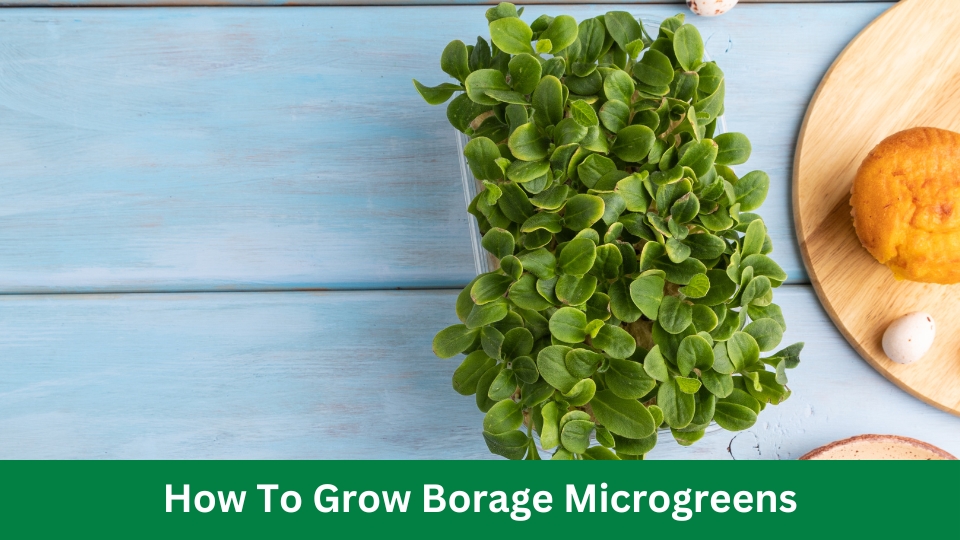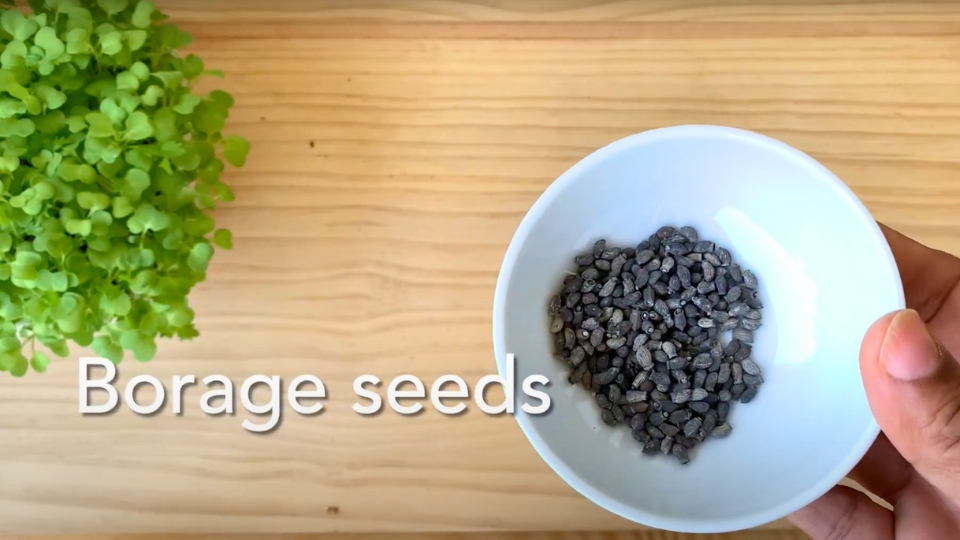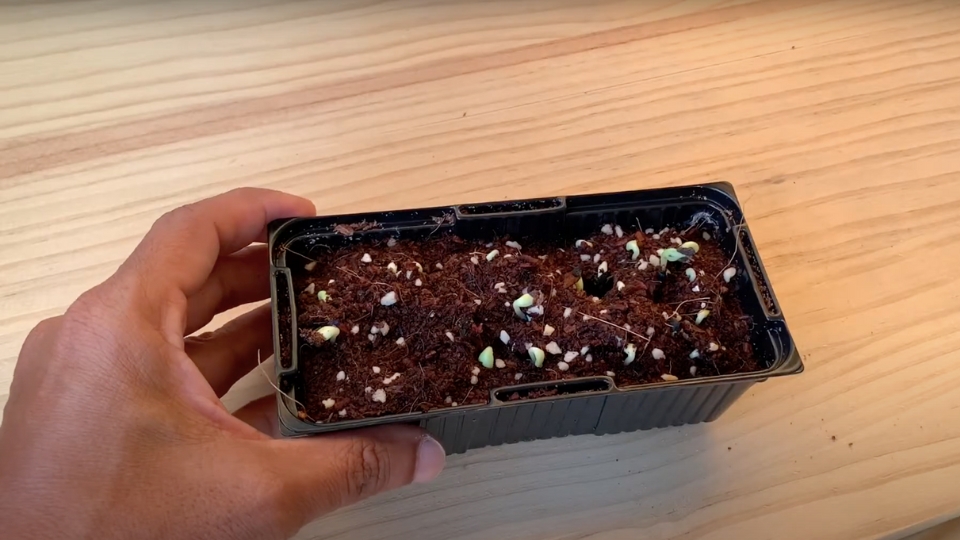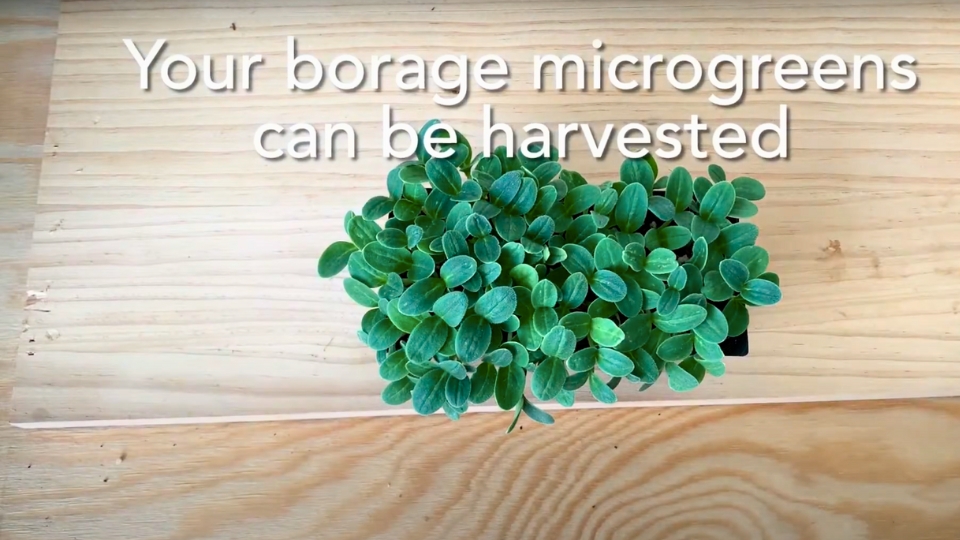
How To Grow Borage Microgreens
To grow borage microgreens, follow these steps: sow borage seeds densely on a growing medium, lightly water them with a spray bottle twice a day, ensure they receive indirect sunlight, and harvest when they reach the desired height. Borage microgreens are nutritious and flavorful, adding colour and taste to salads, sandwiches, and other dishes.
These tiny greens are packed with vitamins A and C, calcium, and potassium, making them a healthy addition to any diet. Growing borage microgreens at home is easy and requires minimal space and effort. We will guide you through Grow Borage Microgreens, from seed to harvest, so you can enjoy these miniature greens’ benefits in no time.
Let’s get started!
Understanding Borage Microgreens
Before you start growing borage microgreens, it’s essential to clearly understand what they are, their benefits, and the ideal conditions for their growth. In this section, we will explore these aspects in detail.
What Are Borage Microgreens?
Borage microgreens, also known as Borago officinalis, are young shoots of the borage plant. These delicate greens are packed with a rich flavour similar to cucumber, making them a popular choice for culinary enthusiasts.
With their vibrant green leaves and attractive star-shaped purple flowers, borage microgreens add visual appeal to any dish.
Benefits Of Growing Borage Microgreens
Growing borage microgreens enhances the taste of your meals and provides several health benefits. These tiny greens are abundant in essential vitamins, minerals, and antioxidants that promote overall well-being. Incorporating borage microgreens into your diet can support healthy digestion, strengthen the immune system, and even help reduce inflammation.
Moreover, borage microgreens contain high levels of gamma-linolenic acid (GLA), an omega-6 fatty acid, which offers numerous benefits, including hormonal balance and skin health improvement.
Ideal Growing Conditions For Borage Microgreens
Providing the ideal growing conditions is crucial to the successful growth and development of borage microgreens. Here are some key factors to consider:
| Factor | Ideal Conditions |
|---|---|
| Light | Borage microgreens thrive in bright but indirect light. Please place them in a well-lit area, such as a windowsill or under grow lights. |
| Temperature | The best temperature range for borage microgreens is between 60°F and 70°F (15°C to 21°C). Maintain a consistent temperature to support optimal growth. |
| Soil | Use a well-draining soil mix with a pH level around 6.0 to 7.0. Ensure the soil is moist but not overly saturated. |
| Watering | Water borage microgreens regularly to keep the soil evenly moist. Avoid overwatering, as it may lead to root rot. |
| Harvesting | When the borage microgreens have developed two sets of leaves, they are ready to be harvested. Snip them above the soil level using clean scissors or a sharp knife. |
By providing these optimal conditions, you can ensure healthy growth and flavorful borage microgreens within a short period of time. Patience is key when growing microgreens, requiring consistent care and attention.
Preparing For Growth
Before you start growing your borage microgreens, it’s important to make sure you set yourself up for success. This includes choosing quality borage seeds, soaking and preparing them properly, and selecting the right growing medium. Let’s delve into these steps to ensure your borage microgreens thrive.
Choosing Quality Borage Seeds
When growing borage microgreens, the first step is selecting high-quality seeds. High-quality seeds contribute to healthy and vigorous growth. Here are some key factors to consider when choosing borage seeds:
- Opt for organic or heirloom seeds from a reputable supplier.
- Check the expiration date to ensure seed freshness.
- Look for seeds that are plump, firm, and have a dark colour.
- Choose seeds that are free from physical damage or signs of pest infestation.
Soaking And Preparing Borage Seeds
Soaking borage seeds before planting can help speed germination and promote successful growth. Follow these steps for soaking and preparing your borage seeds:
- Place the borage seeds in a clean container.
- Add enough water to the container to cover the seeds.
- Let the seeds soak for about 12–24 hours.
- After soaking, drain and rinse the seeds thoroughly.
- Spread the seeds evenly on a damp paper towel and cover with another.
- Keep the seeds covered and moist for 12–24 hours, ensuring they don’t dry out.
Selecting The Right-Growing Medium
Choosing the appropriate growing medium is crucial for the successful growth of borage microgreens. Here are some popular choices that work well:
| Growing Medium | Features |
|---|---|
| Seedling Mix | Lightweight, sterile, and ideal for microgreens |
| Coco Coir | It is environmentally friendly, retains moisture well, and promotes root growth. |
| Vermiculite | Provides good aeration and moisture retention |
Whichever growing medium you choose, ensure it is well-draining and free of pathogens that could harm your borage microgreens. Remember to moisten the growing medium before planting the soaked seeds, as it helps germinate.
Growing Borage Microgreens
Growing borage microgreens is a rewarding and fascinating process that allows you to enjoy the fresh, delicate flavour of these nutritious greens in your kitchen. With a few simple steps, you can have a constant supply of borage microgreens ready to enhance your salads, sandwiches, and other dishes.

This section will walk you through sowing borage seeds, providing optimal lighting, controlling temperature and humidity, watering and moisture management, ventilation, and air circulation.
Sowing Borage Seeds
Sowing borage seeds is the first step towards growing healthy and vibrant microgreens. Here’s how you can do it:
- Fill a shallow container or tray with a well-draining potting mix.
- Scatter the borage seeds evenly across the surface of the soil.
- Lightly press the seeds into the soil, ensuring good seed-to-soil contact.
- Cover the seeds with a thin layer of soil or vermiculite.
- Mist the soil gently with water.
- Place the container in a warm and well-lit location, preferably near a window receiving plenty of sunlight.
- Keep the soil consistently moist by misting it daily.
Providing Optimal Lighting
Proper lighting is crucial for the growth and development of healthy borage microgreens. Follow these tips to ensure your microgreens receive optimal lighting:
- Place the tray of borage microgreens in a well-lit location, ideally near a window with direct sunlight.
- Ensure that the microgreens receive at least 6-8 hours of natural light per day.
- If natural light is insufficient, consider using artificial grow lights for indoor gardening.
- Keep the lights positioned 4-6 inches above the microgreens to provide adequate intensity without causing heat stress.
- Keep the lights on for approximately 14-16 hours each day to mimic the natural daylight hours.
Controlling Temperature And Humidity
Controlling the temperature and humidity levels is essential for the successful growth of borage microgreens. Here are some guidelines to help you maintain ideal conditions:
- Keep the temperature at 60–70°F (15-21°C) during the day and slightly more relaxed at night.
- Use a thermometer to monitor the temperature and make adjustments as needed.
- Ensure the humidity level stays between 40-60% to prevent the microgreens from drying out.
- Use a humidifier or regularly mist the air around the microgreens to maintain adequate moisture.
- Provide proper ventilation to prevent mold or fungal growth if the humidity level is too high.
Watering And Moisture Management
Effective watering and moisture management are vital for the health and growth of borage microgreens. Follow these recommendations:
- Water the microgreens gently and evenly to avoid dislodging the seeds or damaging the delicate roots.
- Keep the soil consistently moist but not waterlogged.
- Regularly check the moisture level by inserting your finger into the soil up to the first knuckle; if it feels dry, it’s time to water.
- Mist the microgreens with water once or twice a day to provide additional moisture.
- Avoid overwatering, as it can lead to root rot and other issues.
Ventilation And Air Circulation
Proper ventilation and air circulation prevent diseases and promote healthy growth in borage microgreens. Consider the following:
- Allow for air circulation around the microgreens by placing a small fan nearby.
- Avoid overcrowding multiple trays together, as this can inhibit proper airflow.
- Open windows or use a small exhaust fan to ensure fresh air exchange.
- Regularly check the microgreens for signs of excess moisture or stagnant air, such as yellowing or wilting.
Nutrient Requirements
Proper nutrition is crucial for growing healthy and vibrant borage microgreens. Providing the right combination of nutrients ensures your microgreens flourish and reach their full potential. In this section, we will explore the nutritional needs of borage microgreens and guide you on effectively meeting those requirements.
Understanding Borage Microgreens’ Nutritional Needs
Borage microgreens have specific nutritional needs that must be met to promote optimal growth. These microgreens require a balanced intake of macronutrients and micronutrients to develop strong stems, lush leaves, and intense flavours. Understanding their nutritional requirements is the first step towards successful cultivation.
Key nutrients that play a vital role in the growth of borage microgreens include:
| Nutrient | Role in Growth |
|---|---|
| Nitrogen (N) | Essential for leaf development and overall plant growth. |
| Phosphorus (P) | Promotes root development and aids in energy transfer. |
| Potassium (K) | Enhances overall plant health, including disease resistance. |
| Calcium (Ca) | Strengthens cell walls and supports proper nutrient absorption. |
| Magnesium (Mg) | Acts as a catalyst for photosynthesis and enhances chlorophyll production. |
Choosing The Right Fertilizer
Choosing the correct fertilizer for your borage microgreens is crucial to ensure they receive the nutrients they need to thrive. When selecting a fertilizer, opt for organic options free from harmful chemicals, as it’s important to prioritize the health and safety of your microgreens.

Consider using a balanced fertilizer with equal ratios of nitrogen (N), phosphorus (P), and potassium (K), such as a 10-10-10 or 14-14-14 blend. These ratios will provide your borage microgreens with a well-rounded nutrient package. However, follow the manufacturer’s instructions for application rates, as over-fertilization can harm your microgreens.
Feeding Borage Microgreens
Feeding borage microgreens involves providing the necessary nutrients throughout their growth cycle. Here are some essential tips for proper feeding:
- During the first week of growth, when the seedlings sprout, water them gently with a diluted half-strength fertilizer solution to provide a mild nutrient boost.
- Once the true leaves emerge (around 7-10 days), gradually increase the strength of the fertilizer solution to the recommended dosage.
- Water your microgreens regularly, using the fertilizer solution instead of plain water. This ensures they receive a consistent supply of nutrients.
- Monitor your microgreens closely for any signs of nutrient deficiencies or excesses. Adjust the fertilizer application accordingly to maintain a healthy balance.
- As the microgreens near harvest, reduce or cease fertilizer application to prevent an unpleasant taste in the final harvest.
Following these feeding guidelines will help you give your borage microgreens the precise nutrients they need throughout their growth journey. Remember, a well-fed microgreen is healthy, flavorful, and visually appealing!
Managing Pests And Diseases
Learn how to effectively manage pests and diseases when growing borage microgreens, ensuring healthy and thriving plants. These tips will help you combat potential problems and cultivate a successful harvest.
Managing Pests and Diseases, Borage microgreens are generally hardy and resistant to pests and diseases. However, it’s important to be aware of common issues affecting them. By implementing effective pest and disease management strategies, you can ensure the health and productivity of your borage microgreens.
This section will discuss the common pests that can affect borage microgreens and provide disease prevention and control strategies to help you keep your plants thriving.
Common Pests That Affect Borage Microgreens
Pests can cause significant damage to your borage microgreens if left untreated. Here are some common pests that you may encounter and tips on how to manage them:
- Aphids: These tiny insects suck the sap from your microgreens, causing wilting and stunted growth. Use insecticidal soap or a strong water spray to dislodge aphids from the plants.
- Spider mites: Spider mites are minuscule pests that spin webs and suck the juice out of the leaves, leading to yellowing and shrivelling. Keep the surrounding area clean and free from debris to discourage these pests. Utilize insecticidal soap or neem oil to control their populations.
- Whiteflies: Whiteflies are small, moth-like insects that feed on plant sap and can transmit diseases. Sticky traps can be placed near your microgreens to catch the adult flies, while a strong stream of water can help dislodge them from the plants.
Disease Prevention And Control Strategies
Diseases can significantly threaten your borage microgreens, affecting their growth and productivity. Here are some effective disease prevention and control strategies to ensure the well-being of your plants:
- Proper sanitation: Regularly clean and sanitize your growing trays, tools, and equipment to reduce the risk of disease transmission. This includes removing any decaying plant matter and sterilizing your equipment.
- Good air circulation: Ensure adequate airflow around your microgreens by spacing them properly and avoiding overcrowding. This will help prevent the development and spread of fungal diseases.
- Water management: Avoid overwatering your microgreens, as excessive moisture can promote the growth of fungal diseases. Water the plants at the base to keep their leaves dry and reduce the risk of infection.
- Biological control: Introduce beneficial insects such as ladybugs and lacewings to your growing area. These predators feed on pests, helping to keep their populations in check and reducing the risk of disease transmission.
- Organic fungicides: If necessary, consider using organic fungicides to control fungal diseases. Products containing copper or neem oil can be effective against various fungal infections.
By being proactive in pest and disease management for your borage microgreens, you can ensure a healthy and thriving crop. Regular monitoring, timely intervention, and proper care will go a long way toward achieving successful cultivation.
Borage Microgreens: Harvesting And Storage
Learn how to grow borage microgreens with step-by-step instructions on harvesting and storage for optimal freshness and flavour.

Once your borage microgreens have reached their desired growth stage, it’s time to harvest and store them properly to maintain their freshness and flavour. This section will discuss the right time to harvest, harvesting techniques, and how to store your borage microgreens for maximum shelf life.
Determining The Right Time To Harvest
Determining the optimal time to harvest your borage microgreens is crucial for their taste and texture.
Generally, microgreens are ready to be harvested when they have developed their first true leaves, typically around 10–14 days after sowing. Observe their growth regularly to ensure you harvest your borage microgreens at the right time.
Look for the appearance of the first set of true leaves, which will be larger and different in shape from their initial cotyledon leaves. Once you spot these leaves, it’s time to harvest and enjoy the flavorful results of your hard work.
Harvesting Techniques
When harvesting borage microgreens, you can use a few techniques. These simple methods will help you gather your microgreens efficiently without causing damage or compromising their quality. One way to harvest borage microgreens is by using a sharp pair of scissors or kitchen shears.
Carefully cut the stems just above the soil level, ensuring you don’t include any soil in the harvest. Remember to sanitize your tools before each harvest to prevent contamination.
Alternatively, gently pull the microgreens from their soil or growing medium, grasping them close to the base to avoid tearing or damaging the delicate stems. This method works well if your microgreens are growing in a loose medium.
Storing Borage Microgreens
Proper storage is essential to prolong the shelf life and preserve the flavour of your borage microgreens. Follow these steps to ensure your microgreens stay fresh and delicious for longer:
- Inspect the harvested microgreens, removing any damaged or wilted leaves.
- Rinse the microgreens gently with cold water to remove any dirt or debris, being careful not to crush or bruise them.
- Pat the microgreens dry with a clean towel or use a salad spinner to remove excess moisture.
- Transfer the dry microgreens to an airtight container or a resealable bag.
- Place a paper towel or a clean cloth inside the container or bag to absorb excess moisture and maintain freshness.
- Store the container or bag in the refrigerator’s vegetable crisper drawer, which provides a cool and humid environment. Borage microgreens can stay fresh for up to a week when properly stored.
Remember to check your microgreens regularly and discard any that show signs of spoilage or have surpassed their shelf life.
By following these harvesting and storage techniques, you can enjoy the vibrant flavour and nutrient-packed goodness of borage microgreens for longer periods, ensuring you have a constant supply of this delightful ingredient for your culinary creations.
Culinary Uses And Recipes
Incorporating Borage Microgreens In Dishes
Borage microgreens add vibrant colour to your dishes and offer a delicate cucumber-like flavour. These tiny greens are versatile and can be used in various culinary creations to enhance taste and visual appeal.
Here are some creative ways to incorporate borage microgreens in your dishes:
- Add them as a garnish to salads, soups, or sandwiches for an extra layer of freshness.
- Mix them into creamy spreads, such as hummus or tzatziki sauce, to add a hint of coolness.
- Toss them into pasta dishes, stir-fries, or omelettes just before serving to add flavour.
- Use them as a topping for bruschetta, pizzas, or tacos for a unique twist on traditional favourites.
Flavor Profile And Pairings
Borage microgreens possess a distinct flavour that sets them apart from other greens. Their taste is often described as fresh, herbaceous, and reminiscent of cucumbers.
To complement their unique flavour, here are some ingredients that pair well with borage microgreens:
- Fresh fruits like strawberries, watermelon, or citrus are a refreshing combination.
- Seafood, such as grilled fish or shrimp, enhances the natural brininess.
- Soft cheeses like goat cheese or feta balance the greens’ mild tang.
- Light dressings are made with lemon, lime, or herb-infused oils to accentuate their herbal notes.
Tasty Recipes With Borage Microgreens
Ready to explore the culinary possibilities? Try these delicious recipes that showcase the flavour and versatility of borage microgreens:
Fresh Summer Salad:
Ingredients:
- 2 cups mixed greens
- 1 cup borage microgreens
- 1 cup cherry tomatoes, halved
- 1/2 cucumber, sliced
- 1/4 red onion, thinly sliced
- 1/4 cup feta cheese, crumbled
- 2 tablespoons lemon vinaigrette
- Salt and pepper to taste
Instructions:
- Combine the mixed greens, borage microgreens, cherry tomatoes, cucumber, and red onion in a large bowl.
- Sprinkle the crumbled feta cheese on top.
- Drizzle the lemon vinaigrette over the salad and toss gently to coat.
- Season with salt and pepper according to your taste.
- Serve immediately, and enjoy!
Cucumber and Borage Microgreen Gazpacho:
Ingredients:
- 2 cucumbers, peeled and diced
- 1 cup borage microgreens
- 1/2 cup Greek yogurt
- 1/4 cup fresh lime juice
- 2 tablespoons extra virgin olive oil
- 1 garlic clove, minced
- Salt and pepper to taste
Instructions:
- Combine the diced cucumbers, borage microgreens, Greek yoghurt, lime juice, olive oil, and minced garlic in a blender.
- Blend until smooth and creamy.
- Season with salt and pepper according to your taste.
- Refrigerate for at least 1 hour to allow the flavours to meld.
- Serve chilled, garnished with additional borage microgreens, if desired.
Frequently Asked Questions Of How To Grow Borage Microgreens
Can You Eat Borage Microgreens?
Yes, borage microgreens are safe to eat. They add a delightful crunch to salads, sandwiches, and other dishes. Enjoy their fresh taste and nutritional benefits.
What Does Borage Microgreen Taste Like?
Borage microgreens have a fresh and mild cucumber-like taste.
Will Microgreens Regrow After Cutting?
Microgreens will regrow after cutting, allowing for multiple harvests. Just trim them about an inch above the soil, and they will send up new shoots for continuous growth.
Decision
Growing borage microgreens can be a rewarding experience for any gardener or food enthusiast. With their delicate flavour and impressive nutritional profile, these tiny greens offer a versatile addition to salads, sandwiches, and other culinary creations.
By following the tips and techniques shared, you can successfully cultivate borage microgreens at home and enjoy their fresh and vibrant goodness.
Get started on your microgreen journey today and reap the benefits of this nutrient-packed superfood.
Video Source: https://www.youtube.com/watch?v=kwIbux4ruVA


